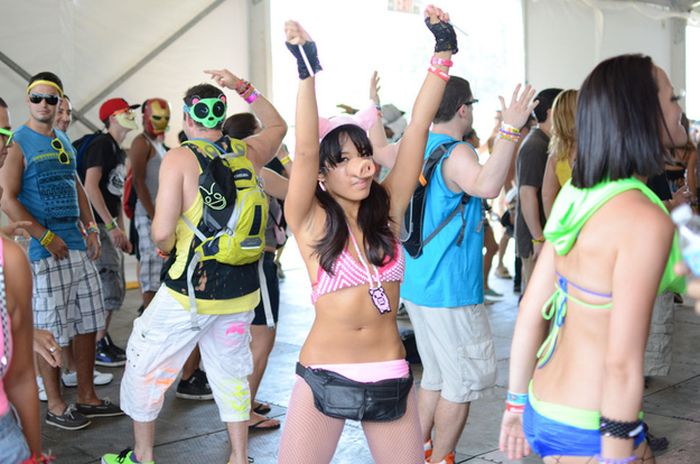|
|
Rave Music Fan Girl
|
With the rapid change of British pop culture from the mod era of 1963–1966 to the hippie era of 1967 and beyond, the term fell out of popular usage. During the 1970s and early 1980s until its resurrection, the term was not in vogue, one notable exception being in the lyrics of the song "Drive-In Saturday" by David Bowie (from his 1973 album Aladdin Sane) which includes the line "It's a crash course for the ravers." Its use during that era would have been perceived as a quaint or ironic use of bygone slang: part of the dated 1960s lexicon along with words such as "groovy". The perception of the word changed again in the late 1980s when the term was revived and adopted by a new youth culture, possibly inspired by the use of the term in Jamaica.
In the mid to late 1980s a wave of psychedelic and other electronic dance music, most notably acid house and Techno, emerged and caught on in the clubs, warehouses, and free-parties around London and later Manchester. These early raves were called Acid House Parties. They were mainstream events that attracted thousands of people (up to 25,000 instead of the 4,000 that came to earlier warehouse parties). Acid House parties were first re-branded "rave parties" in the media, during the summer of 1989 by Neil Andrew Megson during a television interview, however, the ambience of the rave was not fully formed until 28 May 1991. In the UK, in 1988-89, raves were similar to football matches in that they provided a setting for working-class unification, in a time with a union movement in decline and few jobs, and many of the attendees of raves were die-hard football fans.
In the late 1980s, the word "rave" was adopted to describe the subculture that grew out of the acid house movement. Activities were related to the party atmosphere of Ibiza, a Mediterranean island in Spain, frequented by British, Italians, and German youth on vacation. The fear that a certain number of rave party attendees used "club drugs" such as MDMA, cocaine, amphetamines and, more recently, ketamine, was taken by authorities as a pretext to ban those parties altogether.
British politicians responded with hostility to the emerging rave party trend. Politicians spoke out against raves and began to fine anyone who held illegal parties. Police crackdowns on these often-illegal parties drove the scene into the countryside. The word "rave" somehow caught on in the UK to describe common semi-spontaneous weekend parties occurring at various locations linked by the brand new M25 London Orbital motorway that ringed London and the Home Counties. (It was this that gave the band Orbital their name.) These ranged from former warehouses and industrial sites, in London, to fields and country clubs in the countryside.
|
|









